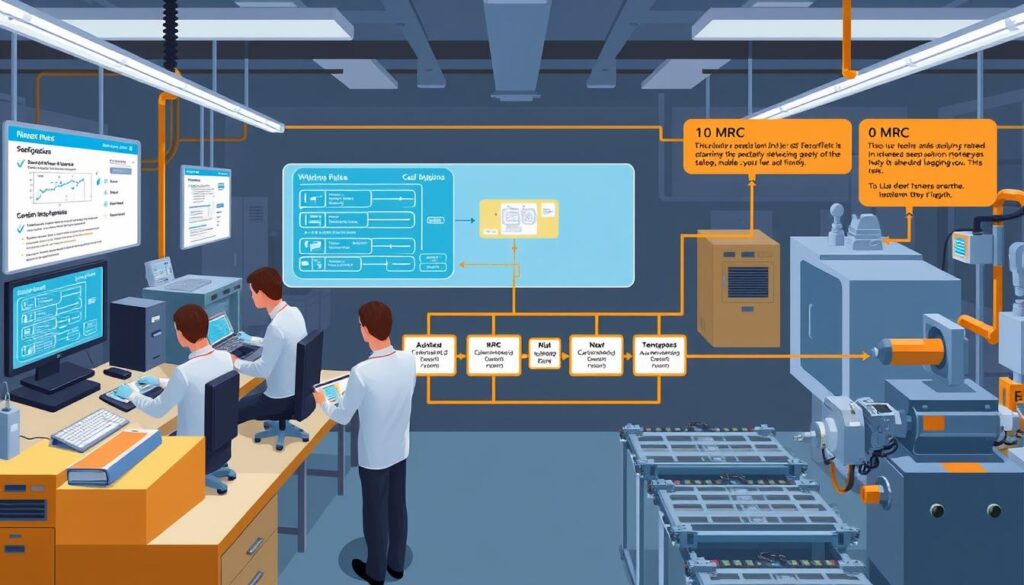In the world of PCB design and electronics manufacturing, the Manufacturing Rule Check (MRC) is key. It makes sure our designs meet industry standards and manufacturing capabilities. MRC is essential before sending designs to fabrication, avoiding costly mistakes and delays.
The PCB design, design for manufacturability (DFM), and electronics manufacturing industries depend on MRC. It ensures high-quality products and smooth production. By checking designs against manufacturing rules, we can fix issues before fabrication.
In this article, we’ll explore Manufacturing Rule Check in detail. We’ll look at its components, industry standards, and its role in production. We’ll also discuss how to implement MRC, its benefits and challenges, and the latest trends in this field.
Table of Contents
Understanding the Basics of Manufacturing Rule Check
Manufacturing Rule Check (MRC) is key in PCB design and production. It checks PCB layouts against manufacturing rules. This ensures they meet fabrication constraints and industry standards.
This detailed check finds problems early. It prevents costly mistakes and delays later on.
Key Components of MRC Analysis
The MRC analysis looks at design elements like trace widths, spacing, and drill sizes. These must match the PCB fabrication process’s capabilities. This ensures the PCB works well and reliably.
Common Manufacturing Rule Parameters
- Minimum trace widths
- Minimum hole sizes
- Clearances between traces and other features
- Aspect ratios for vias and plated through-holes
- Copper weight and thickness requirements
Industry Standards and Guidelines
Industry standards like IPC-2221 and IPC-7351 guide MRC. They help ensure PCB designs follow best practices. This is for fabrication, assembly, and product reliability.
The Critical Role of Manufacturing Rule Check in Production
Manufacturing Rule Check (MRC) is key to making production processes better. It spots problems early, leading to better yield improvement, fewer defects, and more production efficiency. This way, companies can fix design issues before they cause trouble in making products. This makes products more affordable and of higher quality.
MRC is great at finding design problems before production starts. This lets manufacturers fix issues early, avoiding expensive reworks or rejects later. By fixing problems early, companies can make more products, which means more profit and happier customers.
Also, MRC helps cut down on defects during making. It sets clear rules and standards, helping find and fix problems before they turn into bad products. This makes products better and reduces the need for extra quality checks, making production smoother.
In short, MRC is vital for improving yield, defect reduction, and production efficiency. It helps companies tackle design and making issues early. This leads to better processes, lower costs, and top-notch products for the market.
| Key Benefits of Manufacturing Rule Check | Metrics Impacted |
|---|---|
| Early identification of design flaws | Yield improvement |
| Reduced defects during production | Defect reduction |
| Streamlined production workflow | Production efficiency |
Manufacturing Rule Check Implementation Process
Setting up a Manufacturing Rule Check (MRC) is a detailed process. It starts with checking designs before they’re made, then documenting everything carefully. It also makes sure quality checks work smoothly. This way, the Printed Circuit Board (PCB) design follows all the rules for making it, leading to a top-notch product.
Pre-production Verification Steps
We do a deep check on designs before making them. This step is key:
- We make sure the PCB design fits the maker’s needs and limits.
- We look at the layout to see if it follows the best practices and rules.
- We check if the design can be made as planned.
Documentation Requirements
Keeping detailed records is a big part of the MRC process. We keep track of:
- PCB design details and blueprints.
- How the PCB is made and quality checks.
- If the design meets all the rules and laws.
- Any changes to the design.
Quality Control Integration
We make sure quality checks are part of every step. This includes:
- Setting up strict checks and tests.
- Using feedback to improve the MRC process.
- Keeping the MRC process up to date.
By making MRC a part of how we work, we keep quality high. This way, we make PCBs that our customers love.

Benefits and Cost Implications of MRC
Using a strong Manufacturing Rule Check (MRC) process brings many benefits to electronics makers. One big plus is reducing manufacturing costs. It helps spot and fix issues early, avoiding expensive rework and recalls later.
Another big plus is speeding up time-to-market. Finding problems before production means less delay. This quickness is key in fast-moving markets.
Most importantly, MRC helps make products more reliable. It ensures designs and manufacturing meet standards. This leads to happier customers and a better brand image.
Though starting MRC might seem costly, the long-term benefits are worth it. It helps cut waste, improve efficiency, and make better products.

To make MRC work well, electronics makers must work together. They should team up with engineering, quality, and production teams. This way, they can make the most of MRC and succeed in the long run.
Best Practices for Manufacturing Rule Check Compliance
Following best practices for manufacturing rule checks (MRC) is key for product success. It helps us design better, cut down on mistakes, and improve how things are made. Let’s look at what makes MRC compliance effective.
Leverage Advanced PCB Design Software
Using top-notch PCB design software with MRC features is a big plus. These tools check design rules as we go, cutting down on mistakes. By using MRC in our design work, we catch problems early and save time and money.
Regularly Update Design Rules
Keeping design rules current is vital for MRC compliance. We need to talk often with our manufacturing partners to know their latest needs. This way, our designs stay up-to-date with manufacturing changes.
Implement Automated MRC Processes
Automating MRC with special software makes things more efficient and accurate. It helps us check designs faster, lowers the chance of mistakes, and keeps quality high. This method saves us time and boosts our design quality.
Following these MRC compliance best practices makes our designs better for making. It cuts down on costly mistakes and delays. By using the latest design tools and MRC automation, we can handle today’s production challenges well. This way, we deliver top-notch products to our customers.
Common Challenges in Manufacturing Rule Check and How to Overcome Them
Dealing with Manufacturing Rule Check (MRC) can be tough. Many manufacturers face problems like conflicting design rules. These rules set by different people can cause delays in production.
Keeping manufacturing data up to date is another big challenge. If the data is old, it can lead to bad design choices. This can cause delays and cost more money.
Good communication between designers and manufacturers is key. Without it, there can be misunderstandings. This can lead to design rule conflicts and production problems.
To solve these issues, manufacturers should talk more with their design teams. Keeping everyone informed about design rule changes and manufacturing capabilities is important. This way, everyone knows what to expect.
Using advanced PCB design tools can also help a lot. These tools can spot design rule conflicts and suggest fixes. This makes the MRC process smoother and faster.
By improving communication, managing data better, and using new design tools, manufacturers can do better. They can make products that meet high standards more easily.
Future Trends in Manufacturing Rule Check Technology
The future of Manufacturing Rule Check (MRC) technology is exciting. It will become smarter and more automated. Advances in artificial intelligence (AI) and machine learning are leading the way. They will make PCB design software more accurate and efficient.
We expect AI and machine learning to be part of design tools soon. These tools will analyze data, spot potential issues, and offer design improvements. This will help PCB designers make better choices early on, avoiding costly mistakes later.
Also, machine learning models will get better with time, thanks to large datasets of PCB manufacturing data. These tools will learn from past experiences and predict manufacturing issues more accurately. This predictive power will be key in following industry standards, making the MRC process smoother.

